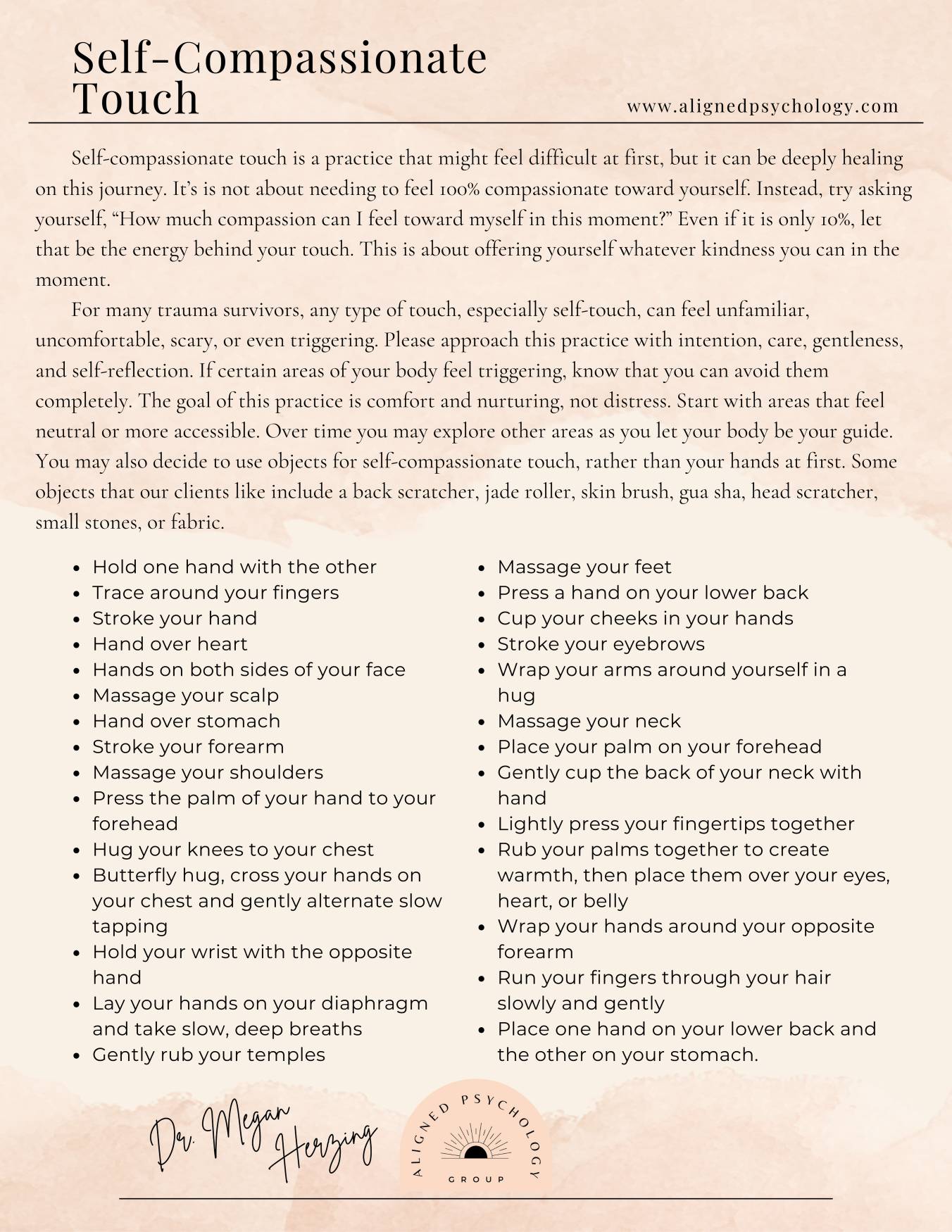Trauma Therapy Homework - Week 10
Week 10: (The Basics)
Self-Compassionate Touch
Welcome to Week 10 of your trauma therapy journey! This week, we’re diving into something that might feel difficult but can be deeply healing: self-compassionate touch. For many trauma survivors, touch—especially self-directed touch—can be unfamiliar, uncomfortable or even scary. But when approached with care and intention, it can become a powerful tool for soothing, regulating, and reconnecting with yourself.
Why Self-Compassionate Touch?
Touch is one of our most natural ways of offering comfort and care. Think about how you might console a friend, a child, or even a pet—through gentle touch, a reassuring hug, or a warm hand on their shoulder. We instinctively use touch to provide safety and connection, yet we often forget to offer this same kindness to ourselves. Self-compassionate touch is about meeting yourself with care. It’s a way to send a message to your nervous system that you are safe, supported, and connected to yourself. This practice can be particularly helpful if you struggle with self-criticism, disconnection from your body, or difficulty with self-regulation.

Setting the Intention
This isn’t just about touching your own body—it’s about how you do it. The intention is to provide support, meet a need, and show compassion for all your body has endured and continues to hold. Think about the way you would show affection to someone you love. Maybe even imagine offering the care you needed as a child, especially if it wasn’t always available to you. Instead of pushing away discomfort or judging yourself, this practice is about meeting your body with warmth. It’s about recognizing all it does for you every day—carrying you, protecting you, adapting to stress—and offering it kindness in return. Self-compassionate touch can become what we call a "somatic resource", which just means a practice you can do with your body that is a tool for regulation, processing or releasing emotions, and feeling more safe in your body.
Ways to Practice Self-Compassionate Touch
Here are some ways you can incorporate self-compassionate touch into your routine. Try a few and see what feels best for you:
- Hold one hand with the other
- Trace around your fingers
- Stroke your hand
- Hand over heart
- Hands on both sides of your face
- Massage your scalp
- Hand over stomach
- Stroke your forearm
- Massage your shoulders
- Press the palm of your hand to your forehead
- Hug your knees to your chest
- Butterfly hug, cross your hands on your chest and gently alternate slow tapping
- Hold your wrist with the opposite hand
- Lay your hands on your diaphragm and take slow, deep breaths
- Gently rub your temples
- Massage your feet
- Press a hand on your lower back
- Cup your cheeks in your hands
- Stroke your eyebrows
- Wrap your arms around yourself in a hug
- Massage your neck
- Place your palm on your forehead
- Gently cup the back of your neck with hand
- Lightly press your fingertips together
- Rub your palms to
- -gether to create warmth, then place them over your eyes, heart, or belly
- Wrap your hands around your opposite forearm
- Run your fingers through your hair slowly and gently
- Place one hand on your lower back and the other on your stomach.
Navigating Triggers
If certain areas of your body feel triggering due to past trauma, know that it’s completely okay to avoid them. The goal is comfort, not distress. Start with areas that feel neutral or more accessible, like your hands, arms, or face. Over time, as you build trust with yourself, you may feel ready to explore touch in other areas like your stomach. Always let your body guide you—this practice is about giving yourself choice and creating safety, not forcing anything uncomfortable.
Another way to support yourself if you feel triggered in this practice is to start by using objects for self-compassionate touch, rather than your hands. Using another external thing might be an easier intro to developing more safety. You can use objects like a back scratcher, jade roller, skin brush, gua sha, or head-scratcher. You can also use things you have lying around the house, like a paintbrush, tennis ball, smooth stones, or fabric.

Self-Compassion is a Practice
You don’t have to feel 100% self-compassionate for this to work. It’s okay if it feels awkward or if resistance comes up. Instead of expecting perfection, ask yourself: “How much compassion can I feel toward myself in this moment?” Even if it’s only 10%, let that small amount be the energy behind your touch. Over time, with practice, that percentage may grow. Self-compassion isn’t about reaching some perfect state of love for yourself—it’s about showing up with whatever kindness you can, in whatever way you can, in this moment.
Noticing How It Feels
As you explore self-compassionate touch, bring a sense of mindfulness to how it feels. Does the warmth of your hand soothe you? Does the pressure feel supportive? Does a particular motion bring a sense of comfort? Simply noticing these sensations without judgment can deepen your connection to your body and help you understand what feels good for you.

Extra Step: Bringing Touch to Areas of Tension or Emotion
If you notice tension or tightness in your body, try bringing self-compassionate touch to that area. Maybe you feel a knot in your stomach when you’re anxious or tightness in your chest when you’re sad. Gently placing your hand there with warmth and kindness can be a way of saying, “I see you. I’m here for you.” Our bodies hold so much, and this is a way to offer care to those places that need it most.
Final Thoughts
Self-compassionate touch is a simple, potentially difficult, yet profound practice that can help you build a sense of safety, connection, and self-kindness. Whether you try just one of these gestures or make it a daily practice, every small act of kindness toward yourself matters. You are worthy of the same love and care that you offer to others. So, as you go through this week, take a moment—just a few seconds—to place a hand on your heart, your arm, or anywhere that feels safe, and remind yourself: I am here for me. I am working on developing compassion for myself. Your body is listening. Let it hear kindness.
FREE Downloadable Handouts
Click this
LINK
for free access to downloadable PDFs from the Trauma Therapy Homework Series. You’ll be directed to my Google Drive folder, where you can explore all the handouts created so far. You can choose between a digital format for easy viewing on your device or a printable version if you prefer a hard copy.
Here is a preview of this week's handout! Click the link above to get your own free pdf copy.


ABOUT THE AUTHOR
Dr. Megan
Megan Herzing PsyD, Licensed Professional Clinical Counselor, specializes in trauma therapy and creating a safe, supportive space for healing. She integrates evidence-based modalities, including EMDR, Internal Family Systems (IFS), somatic therapy, and Emotionally Focused Therapy (EFT), to address the mind-body connection and empower clients on their journey to wellness. With extensive experience treating complex PTSD, anxiety, attachment injuries, and dissociation, she believes in the power of self-compassion and authentic connection to facilitate lasting change. Drawing from her own healing journey, she brings empathy and lived experience to her work, honoring each client’s unique path toward growth and resilience.
Thank you for being part of a community of humans that deeply cares about healing.
We are honored that you stopped by and hope our resources will continue to bring value to your life.
We are accepting new clients in California, and referrals are always appreciated.












